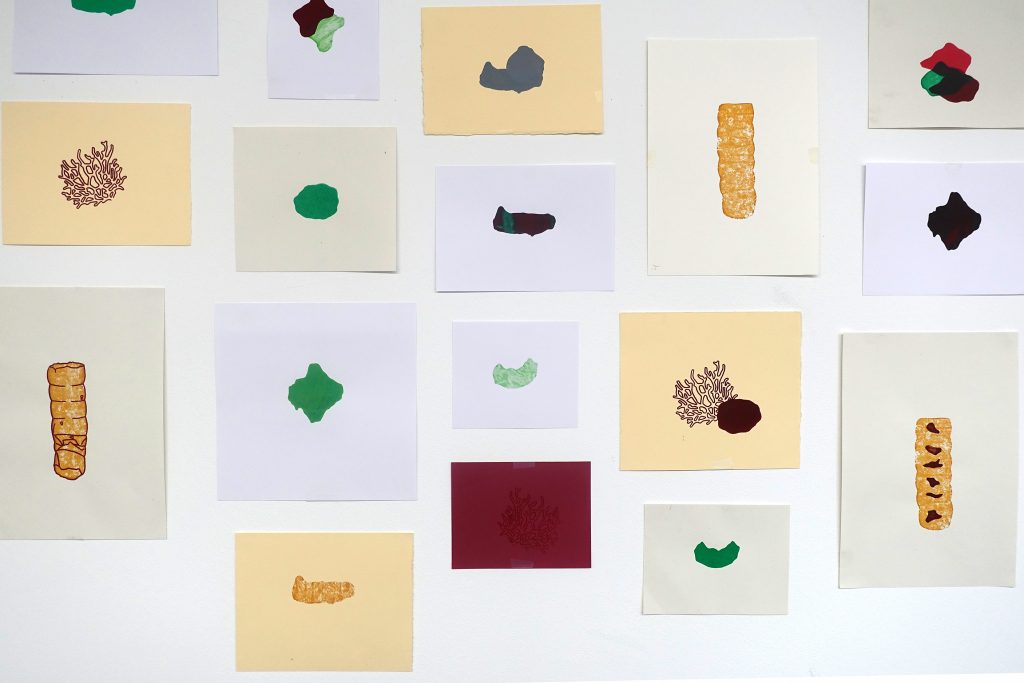THE FLOWERS OF TIME
2021
Silkscreen on different papers. Variable dimensions.
Pilar Juncosa & Sotheby’s Awards and Grants 2020. Grant for accommodation and participation at the Slade School of Fine Art, University College, London (UK).
Complex life forms may have existed on the planet much earlier than previously thought. The discovery of red algae fossils dating back one billion six hundred million years pushes back the appearance of multicellular organisms in the evolutionary tree by four hundred million years. The discovery was made by researchers from the Swedish Museum of Natural History. The two types of fossils found in sedimentary rocks near the town of Chitrakoot (India) represent the oldest known complex life forms to date. For a more accurate identification, they analyzed the interior of the fossil using synchrotron X-ray tomography, a new technique that allows scanning fossils in three dimensions.
These images serve as references for the creation of the work shown here. In this way, depending on the level of observation (in physics, these would be the microscopic and macroscopic levels) and the complexity of the objects in the scene, different realities are described. The preservation of this fossil also inspires reflection on how life could develop under conditions of microgravity and isolation in outer space.
The Garden of Time is a literary reference from a fantasy story by J.G. Ballard, where a couple tries to fend off an enraged crowd surrounding their home with the intent of taking and destroying it. Isolated in their home, this couple of lovers make use of the magical properties of the flowers in their garden to slow down time for a few minutes, attempting to defend themselves while gradually depleting their defensive resources, their garden, and, to some extent, accepting that the end of their lives is near. While waiting with this sort of resignation for their fate, they contemplate the beauty of the garden they inhabit, full of exotic and strange flowers that slowly begin to fade.

LAS FLORES DEL TIEMPO
2021
Serigrafía sobre diferentes papeles. Dimensiones variables.
Premios Pilar Juncosa & Sotheby’s 2020. Beca de residencia y participación en la Slade School of Fine Art, University College, Londres (UK).
Las formas de vida complejas podrían haber existido en el planeta mucho antes de lo que se creía. El hallazgo de fósiles de algas rojas con una antiguedad de mil seiscientos millones de años, retrasa en cuatrocientos millones de años la aparición de organismos multicelulares en el árbol de la evolución. El descubrimiento fue realizado por Investigadores del Museo Nacional de Historia de Suecia. Los dos tipos de fósiles hallados en rocas sedimentarias cerca de la localidad de Chitrakoot (India), suponen las formas de vida compleja más antiguas encontradas hasta el momento. Para una identificación más precisa, analizaron el interior del fósil utilizando microscopia tomográfica de rayos X de fuente sincrotón, una nueva técnica que permite escanear los fósiles en tres dimensiones.
Estas imágenes sirven de referencia para la realización de la obra que se presenta aquí. De esta manera, según sea el nivel de observación (en física serian el microscópico y el macroscópico) y según sea la complejidad de los objetos en escena, se describen diferentes realidades. La conservación de este fósil inspira también a reflexionar sobre como se puede desarrollar la vida en condiciones de microgravedad y aislamiento en el espacio exterior.
El jardín del tiempo consiste en una referencia literaria correspondiente a un relato de fantasía de J. G. Ballard, donde una pareja trata de contener el ataque de una multitud enardecida que está rodeando el lugar en el que viven con objeto de tomarlo y destruirlo. Aislados en su domicilio, esta pareja de amantes hacen uso de las propiedades mágicas de las flores de su jardín para ralentizar el tiempo por unos minutos y así tratar de defenderse, agotando paulatinamente sus recursos defensivos, su jardín y, en cierta medida, asumiendo que el fin de sus vidas está cercano. Mientras esperan con esta suerte de resignación su destino, contemplan la belleza del jardín que habitan, lleno de flores exóticas y extrañas que poco a poco se van consumiendo.
© 2025 www.marguerrero.net